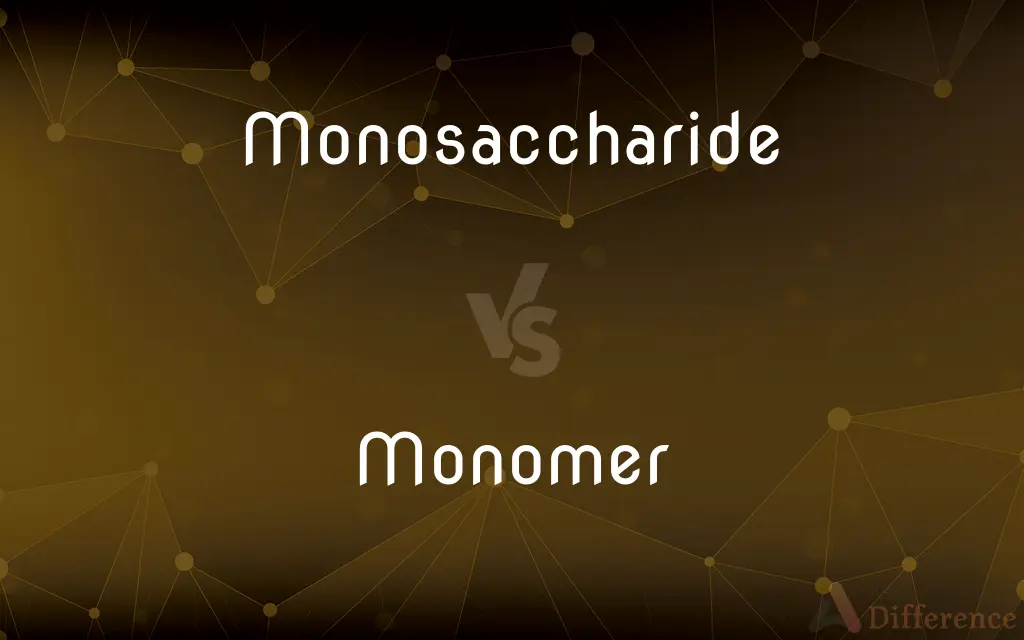Monosaccharide vs. Monomer — What's the Difference?
Edited by Tayyaba Rehman — By Fiza Rafique — Updated on March 27, 2024
Monosaccharides are simple sugars, while monomers are basic building blocks of polymers.

Difference Between Monosaccharide and Monomer
Table of Contents
ADVERTISEMENT
Key Differences
Monosaccharides, also known as simple sugars, are the most basic form of carbohydrates. They consist of single sugar molecules and cannot be hydrolyzed into simpler compounds. Common examples include glucose, fructose, and galactose. Monosaccharides play crucial roles in energy storage, cellular communication, and as building blocks for more complex carbohydrates like disaccharides and polysaccharides.
Monomers, on the other hand, are the basic molecular units that bind together to form polymers, which are large, complex molecules. Monomers can be of various types, including amino acids (which form proteins), nucleotides (which form nucleic acids like DNA and RNA), and monosaccharides themselves (which can form polysaccharides). The diversity of monomers allows for the creation of a vast array of polymers, each with unique properties and functions in biological and synthetic contexts.
The key distinction between monosaccharides and monomers lies in their scope and functionality. Monosaccharides are specifically single sugar molecules with roles primarily related to energy and the foundation of complex carbohydrates. In contrast, monomers encompass a broader category, including but not limited to sugars, that serve as building blocks for a wide range of polymers essential for life and various industrial applications.
While monosaccharides are a type of monomer, not all monomers are monosaccharides. This differentiation is crucial in understanding the structural and functional diversity of biological molecules. Monosaccharides are involved in metabolic pathways, providing energy and serving as intermediates in the synthesis of other biomolecules. Monomers, more broadly, contribute to the structural complexity and functional capabilities of living organisms and synthetic materials through their ability to form polymers with specific and diverse characteristics.
The synthesis and breakdown processes for these molecules differ significantly. Monosaccharides, being simple sugars, can be absorbed directly by organisms for energy or converted into other forms of carbohydrates. Monomers, depending on their type, may require enzymatic reactions to link into polymers or to be broken down into simpler units for use by an organism or in a chemical process.
ADVERTISEMENT
Monosaccharides are a specific subset of monomers that play key roles in energy provision and form the basis of complex carbohydrates, while monomers represent a broader class of molecules that can link to form polymers, essential for biological structures and functions.
Comparison Chart
Definition
The simplest form of carbohydrates; single sugar molecules.
Basic molecular units that bind together to form polymers.
Examples
Glucose, fructose, galactose
Amino acids, nucleotides, monosaccharides
Function
Energy source, building blocks for complex carbohydrates.
Building blocks for polymers like proteins, nucleic acids, polysaccharides.
Role in Biology
Metabolic energy, cellular communication.
Structural, functional, and genetic materials.
Complexity
Cannot be hydrolyzed into simpler compounds.
Can combine to form complex polymers.
Compare with Definitions
Monosaccharide
Cannot be broken down further.
Ribose, a monosaccharide, is a key component of RNA.
Monomer
Can be various molecules.
Nucleotides, monomers of DNA, encode genetic information.
Monosaccharide
Simplest carbohydrate form.
Glucose is a monosaccharide that provides energy to cells.
Monomer
Building block of polymers.
Amino acids are monomers that form proteins.
Monosaccharide
Found in various foods.
Honey is rich in the monosaccharides glucose and fructose.
Monomer
Versatile in function.
Monomers like acrylamide are used in making polyacrylamide gels for laboratory electrophoresis.
Monosaccharide
Single sugar molecule.
Fructose, found in fruits, is a sweet-tasting monosaccharide.
Monomer
Essential for life.
Glucose, a monosaccharide monomer, is vital for energy production.
Monosaccharide
Involved in energy provision.
Galactose, a monosaccharide, is important for energy in young mammals.
Monomer
Forms complex structures.
Styrene monomers polymerize to form polystyrene, a plastic.
Monosaccharide
Monosaccharides (from Greek monos: single, sacchar: sugar), also called simple sugars, are the simplest form of sugar and the most basic units (monomers) of carbohydrates. The general formula is CnH2nOn, or [Cn(H2O)n] or { CH2O}n albeit not all molecules fitting this formula (e.g.
Monomer
A monomer ( MON-ə-mər; mono-, "one" + -mer, "part") is a molecule that can react together with other monomer molecules to form a larger polymer chain or three-dimensional network in a process called polymerization.
Monosaccharide
Any of several carbohydrates, such as tetroses, pentoses, and hexoses, that cannot be broken down to simpler sugars by hydrolysis. Also called simple sugar.
Monomer
A molecule that can be bonded to other identical molecules to form a polymer.
Monosaccharide
(carbohydrate) A simple sugar such as glucose, fructose or deoxyribose that has a single ring
Monomer
A molecule that can combine with other molecules to form a polymer.
Monosaccharide
A simple sugar; any of a number of sugars (including the trioses, tetroses, pentoses, hexoses, etc.), not decomposable into simpler sugars by hydrolysis. Specif., as used by some, a hexose. The monosaccharides are all open-chain compounds containing hydroxyl groups and either an aldehyde group or a ketone group.
Monomer
(chemistry) A relatively small molecule which can be covalently bonded to other monomers to form a polymer.
Monosaccharide
A sugar (like sucrose or fructose) that does not hydrolyse to give other sugars; the simplest group of carbohydrates
Monomer
The basic conceptual building unit of a polymer; a molecule of low molecular weight which may combine with other molecules to form a molecule in a chain or branched form having high molecular weight; as, amino acids are the monomer units which are combined to form proteins; vinylic plastics are formed from monomers having a vinyl group.
Monomer
A simple compound whose molecules can join together to form polymers
Common Curiosities
What makes a molecule a monomer?
Its ability to bind with other similar or identical molecules to form a polymer.
Are monomers always simple molecules?
Monomers can be relatively simple (like monosaccharides) or complex (like nucleotides), depending on the polymer they form.
How do monosaccharides provide energy?
They are metabolized in cells to produce ATP, the energy currency of the cell.
How do organisms use monosaccharides apart from energy?
Besides energy, they are used in biosynthesis of nucleotides and certain amino acids, and as structural components.
How are polysaccharides formed from monosaccharides?
Through dehydration synthesis, where monosaccharides are linked together, releasing water molecules.
Can monosaccharides be considered polymers?
No, monosaccharides are monomers; when they join, they form polysaccharides, which are polymers.
How are monosaccharides involved in cellular communication?
They are components of cell surface markers and signaling molecules that facilitate cell recognition and communication.
Are all monosaccharides monomers?
Yes, monosaccharides can act as monomers when they join to form polysaccharides.
Can monomers only create biological polymers?
No, monomers can form both biological polymers (like proteins and DNA) and synthetic polymers (like plastics).
What role do monomers play in genetics?
Nucleotide monomers make up nucleic acids, which store and transmit genetic information.
Can monomers function independently?
Some monomers have independent functions, while others primarily function as part of polymers.
What is the difference between monomers in DNA and RNA?
DNA contains deoxyribose sugar in its nucleotide monomers, whereas RNA contains ribose sugar, affecting their structure and function.
How are monomers identified in a lab?
Through various analytical techniques, including mass spectrometry and chromatography, based on their chemical properties.
What is the significance of synthetic monomers?
Synthetic monomers are crucial for creating a wide range of materials, including plastics, fibers, and resins, with various industrial applications.
Why are monomers important in biology?
They are the foundation of biological macromolecules, critical for structure, function, and regulation in organisms.
Share Your Discovery

Previous Comparison
Pence vs. Cent
Next Comparison
Breadth vs. LengthAuthor Spotlight
Written by
Fiza RafiqueFiza Rafique is a skilled content writer at AskDifference.com, where she meticulously refines and enhances written pieces. Drawing from her vast editorial expertise, Fiza ensures clarity, accuracy, and precision in every article. Passionate about language, she continually seeks to elevate the quality of content for readers worldwide.
Edited by
Tayyaba RehmanTayyaba Rehman is a distinguished writer, currently serving as a primary contributor to askdifference.com. As a researcher in semantics and etymology, Tayyaba's passion for the complexity of languages and their distinctions has found a perfect home on the platform. Tayyaba delves into the intricacies of language, distinguishing between commonly confused words and phrases, thereby providing clarity for readers worldwide.
















































